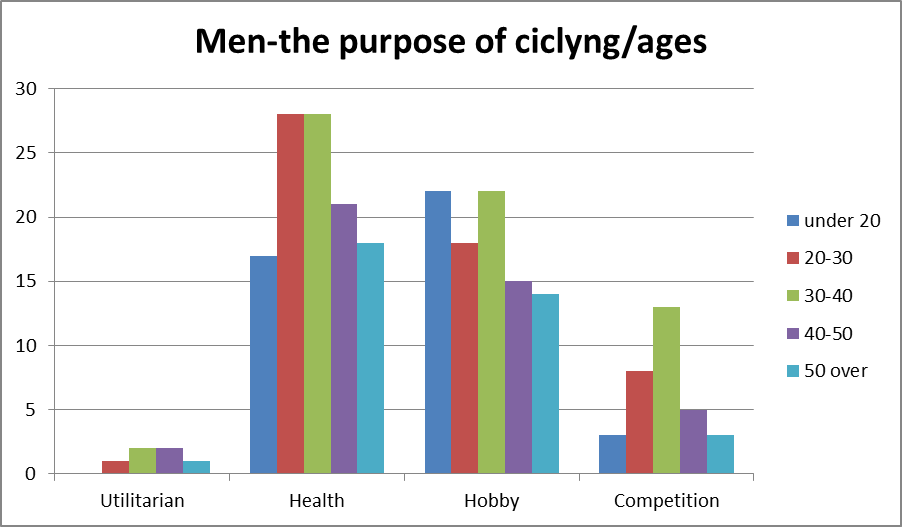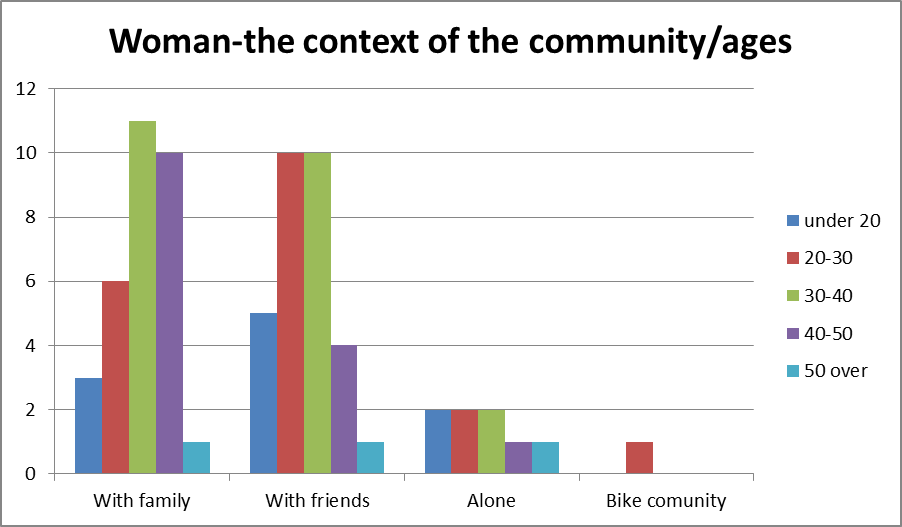Abstract
Cycling has achieved more and more significant meanings in the European contemporary society’s life. It is promoted on a wider-and-wider social, cultural and sport level and it has influences which were unsuspected before. This study has revealed the behavioural profile of the urban cyclists in Romania, which is a European country with a big deficit of cycling specialized infrastructure. Having interviewed 235 men and 70 women, urban cyclists, during 2016-2018, has enabled us to carry out eight comparisons upon different criteria, at five different age categories. The results highlight the profile of the cycling practitioners, according to their gender and age, the differences between the groups being calculated by the chi square test. Among the results we notice aspects such as: men complete their sport activism especially with football, as compared to women who practise indoor fitness mainly; men cycle about two times more frequently, they spend approximately two times more time on their bike and they cover about three times bigger distances in comparison with women. Both gender groups generally invest 200-500 euro in this physical activity aimed at cultivating health, whereas the utilitarian purpose is almost inexistent. Both gender subjects admit that important benefits are burning excess calories and fighting stress. Basically, both gender categories prefer cycling with friends, even though a lot of men practise the activity individually as well, or in cycling communities, while women prefer cycling within their families.
Keywords: Cyclingagesmenwoman
Introduction
Starting from the need of moving around easily, in correlation with the cost of purchasing a vehicle during the interwar period, riding a bike has become a sport, a hobby and even a lifestyle. It’s also promoted on most health channels by providing a mental and physical well-being, sustaining the multilateral functionality of the body; goes hand in hand with the environment, promoting outdoor movement and helping to reduce pollution. Cycling is also related to the cultural development of society, cycling paths in Europe facilitating cultural exchanges and highlighting historical heritage; It’s an economic engine generating a distinct manufacturing sector, requiring the construction of specific infrastructures (Aranburu Plaza, & Esteban, 2016), including the track corridors that cross Europe today, also contributing to the extremely beneficial exploitation of mountain resorts (Badau & Badau, 2018), including the use of climbing means; Because of cycling there are events with the participation of significant biker communities as well as great sporting events promoted at the highest international media level. While cycling infrastructures in most European countries form a more and more laborious network, crossing the continent in all directions, in Romania their development level is particularly low. In Europe, cycling has become part of the daily routine for going shopping, going to school, to work or to the park, but in Romania a significant percentage of the population does not master the cycling technique, school curriculums do not include cycling learning facilities for students, and cycling is discriminating in terms of social status since poor population can’t afford to acquire a bicycle.
In the context of the public European discussions over the reimbursement by the national health system of some expenses towards professionals who offer physical training services or promote fitness centres as medical centres that support public health (Luzi, 2012), the first public policies of supporting needy families in order to buy their first bike have appeared in Romania. Scientifically speaking, a series of benefits deriving from practising cycling are recognised for large masses of population, among which outstands burning excess calories, concomitantly with losing weight. However, there are also articles which present health disorders, generally related to practising cycling too intensely (Rajasekhar, 2014; Nichols, Racinais, Buchheit, & Girard, 2015) or related to the insufficient level of infrastructure development (Lloyd, Tucker, Archbold, & Eames, 2017). The worldwide unprecedented development of cycling offers a particularly wide range of manifestations, practice and development of road or mountain cycling, as well as of flat or ascending cycling (Berkemeier, Reede, & Alumbaugh, 2017); the scientific approaches target interesting aspects of competitive cycling (Paludo, Cook, Owen., Woodman, Owen, & Crewther 2017; Schneeweiss Haerlen, Ahrend, Niess, & Krauss, 2018; Lillo-Bevia, Morán-Navarro, Cerezuela, Martínez-Cava & Pallarés, 2017). In the scientific analysis of cycling it is frequently used the comparison of different categories of practitioners (Bouillod, Brunet, Soto-Romero, & Grappe, 2017), or the association of cycling with other sports (Freda, et al., 2017).
Problem Statement
The relationship between the lack of appropriate infrastructure and the Romanian cyclists adjustment to the tendencies of increasing the bicycle role in society life.
Research Questions
Establishing the behavioural profile of the cyclist in the Romanian urban space leads to the optimisation of the intervention measures meant to support cycling, with social, cultural and economic effects.
Purpose of the Study
To establish the profile of the urban cyclist in Romania, according to age and gender criteria.
Research Methods
The research methods we used were the following: investigation by interview, pedagogical observation, graphical and table method, statistical interpretation. During 2016-2018, 235 men and 70 women were interviewed, of different ages, ranging from under 20 years old to over 50 years old, based on a standardised form with 8 questions. Relevant responses were obtained based on the analysis of 5 questions:
Question 1: What other sports do you practice? The respondents offered maximum 3 answers, regarding other sports or movement preoccupations, more or less organised;
Question 2: How many kilometres do you cover on average in a week?
Question 3: How much have you spent for this hobby? The answers were collected using the national currency but in this material they are presented in EURO.
Question 4: Why do you do this? The respondents were prompted to choose the right answer out of four pre-established possibilities.
Question 5: Who do you get together with when you practise cycling? The respondents were prompted to choose the right answer out of four pre-established possibilities.
The results collected as categorical data (frequent response) were statistically interpreted with the Chi Square test, focusing in particular on gender differences. Data was processed through SPSS, 20.0.
Responses without statistical relevance were recorded in the following 3 questions: How many hours do you spend on a bike in a week on average? With what frequency do you use the bike in a week on average? What benefits do you consider that cycling brings to you? The respondents were prompted to choose the right answer out of seven pre-established possibilities.
The responses for this 3 questions are summarized only in the conclusions.
Findings
From the Table


As can be seen from Figure


Figure


From the Figure


Figure


Comparing Figure
Conclusion
This study highlighted the behavioural profile of the Romanian citizens, of both genders, on a wide range of ages, who practise cycling. In relation to this subject, Romania outstands negatively within the European space, by lack of infrastructure for cycling. In spite of this fact, citizens of all ages and both genders practise cycling more and more. The importance of this study lies in the fact that it seizes present-day data related to mass cycling in Romania, on different issues, ages and genders and the future research shall be able to highlight the directions of this phenomenon development in an easier way. The concrete results, with the statistically significant difference, show that, along with cycling, men also practise sports games (in special football), while women practise fitness activities. When growing older, men generally give up contact sports, while women turn to less and less sportive alternatives. Jogging, swimming and tennis are similarly practised by both men and women, especially at young and mature ages.
In a week, most men cross over 20 Km, while most women go on cycling under 20 km. Most frequently, the financial effort supported by both men and women with a view to practise cycling ranges from 200 to 500 euro. However, women use cheaper bikes, which cost under 200 euro, in comparison with men who are willing to spend over 500 euro, especially in correlation with ages between 30-40 and 40-50 years old.
Both men and women use the bicycle with a strict utilitarian purpose very rarely, in order to move to and from their workplace/activity, or to go shopping. The main purpose of cycling, at both gender categories, is to promote health, a healthy lifestyle, followed by the satisfaction of having and maintaining a hobby.
Men practise cycling firstly with their friends, but also by themselves or in cyclists communities, while women prefer their family and the group of friends. Women practise cycling individually or within cyclists communities to a small extent.
While men spend between 3 and 7 hours weekly on their bikes, with 2-3 outings, women are less active on their bikes, reporting an activity between 1 and 5 hours, in 1-2 outings. Both men and women use the bicycle with a strict utilitarian purpose very rarely, in order to move to and from their workplace/activity, or to go shopping. The main purpose of cycling, at both gender categories, is to promote health, a healthy lifestyle, followed by the satisfaction of having and maintaining a hobby.
References
- Aranburu, I, Plaza, B., & Esteban, M. (2016). Sustainable cultural Tourism in Urban Destination: Does Space Matter? Susteinability, 8, 699.
- Badau, D, & Badau, A. (2018). The Motric, Educational, Recreational and Satisfaction Impact of Adventure Education Activities in The Urban Tourism Environment. Susteinability, 10.
- Berkemeier, Q.N., Reede M., & Alumbaugh B. (2017). Uphill Cycling: Seated versus Standing Economy and Heart Rate. Journal of Science and Cycling, 6(2), 7-9.
- Bouillod, P A., Brunet, E., Soto-Romero, & G., Grappe F. (2017). Influence of power output on pedalling biomechanical parameters in cyclists of different competitive levels. Journal of Science and Cycling, 6(3), 13-14.
- Freda, D., Skoe, T., Cave, C., Wehrli, M., Fox, B., Alumbaugh, B., Reeder, & M., Heumann, K. (2017). Effects of Weight Bearing and Non-Weight Bearing Sports on Bone Quality in Male Collegiate Athletes. Journal of Science and Cycling, 6(3), 21-22.
- Lillo-Bevia, J. R., Morán-Navarro, R., Cerezuela, V., Martínez-Cava, A., & Pallarés, J. G. (2017). A 1-day maximal lactate steady-state assessment protocol for trained cyclists. Journal of Science and Cycling, 6(2), 9-16. https://dx.doi.org/ 10.28985/180630.jsc.03
- Lloyd, R., Tucker, A., Archbold, P., & Eames, N. (2017). The changing face of serious bicycle injuries from a UK Regional Trauma Centre. Journal of Science and Cycling, 6(3), 52-53.
- Luzi L. (2012). What’s new with physical exercise in 2012? Sport Sci Health, 7(1–3). https://dx.doi.org/10.1007/s11332-012-0104-y
- Rajasekhar, K. V. (2014). Acute cycling sport causes upper respiratory tract infections and lung function loss among male recreational cyclists of different age groups. Journal of Science and Cycling, 3(2), 44.
- Nichols, D., Racinais, S., Buchheit, M., & Girard, O. (2015). Thresholds in ventilation, cerebral and muscle oxygenation, and muscle activity during incremental cycling exercise. Journal of Science and Cycling, 4(2), 14-15.
- Paludo, A. C., Cook, C. J., Owen, J. A., Woodman, T., Owen, S., & Crewther, B. T. (2017). Psycho-physiological responses of mountain bike riders during anaerobic and aerobic testing. Journal of Science and Cycling, 6(1), 18-25.
- Schneeweiss, P., Haerlen, S., Ahrend, M.-D., Niess, A. M., & Krauss, I. (2018). Agreement between the Stages Cycling and PowerTap Powermeter. Journal of Science and Cycling, 7(1), 3-8, https://dx.doi.org/
Copyright information

This work is licensed under a Creative Commons Attribution-NonCommercial-NoDerivatives 4.0 International License.
About this article
Publication Date
15 August 2019
Article Doi
eBook ISBN
978-1-80296-066-2
Publisher
Future Academy
Volume
67
Print ISBN (optional)
-
Edition Number
1st Edition
Pages
1-2235
Subjects
Educational strategies,teacher education, educational policy, organization of education, management of education, teacher training
Cite this article as:
Rosu*, D. (2019). Multidisciplinary Connotations Of The Development Of Cycling In The Life Of Society. In E. Soare, & C. Langa (Eds.), Education Facing Contemporary World Issues, vol 67. European Proceedings of Social and Behavioural Sciences (pp. 755-763). Future Academy. https://doi.org/10.15405/epsbs.2019.08.03.90
